Reconnaissance for the Ionic Pulse
Dec 21, 2014
I’ve been at my fieldcamp next to Canada Glacier for a few weeks now, waiting for the melt season to start. And… it hasn’t. Every week I’ve been hiking up the mountainside and onto the top of Canada to look for surface melt, but the surface pools (see my blog post on surface pool cryoconites here) are still frozen over, even on warmer days. Last year there was far more melting at this point in the season, which has led a few people to ask me “So is this year colder? Does that mean climate change has stopped or isn’t real?”
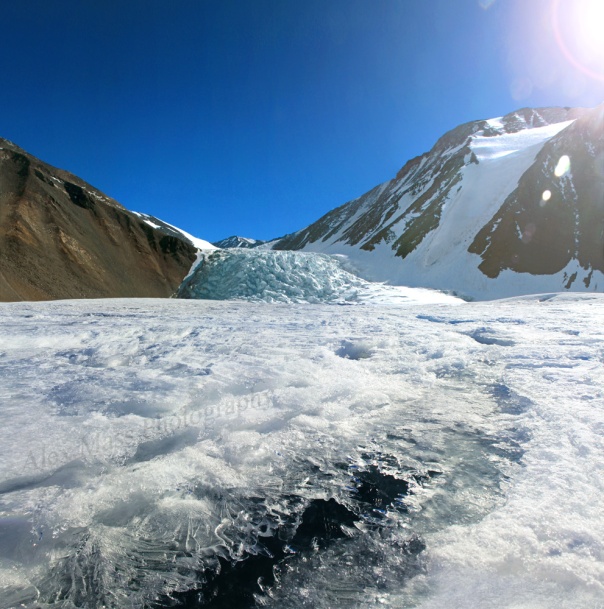
Meltwater streaming through Canada Glacier in December 2013. In addition to the melt, ablation (evaporation of ice into air in very dry, sunny and cold climates) removes the snow first, then starts removing surface ice into the soft and ‘punchy’ (low-density) layers seen here.
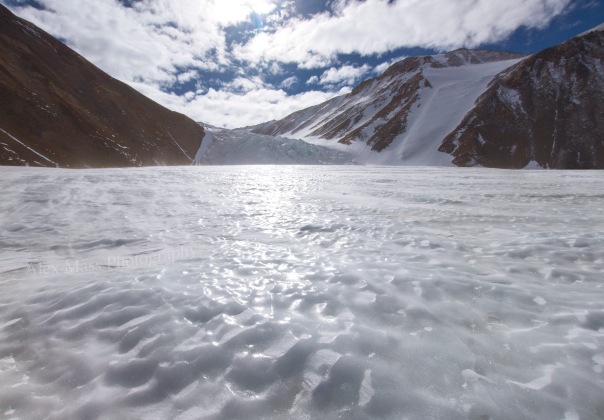
The same location on Canada Glacier in December 2014. The surface ice is still very dense and slippery, with wisps of snow blowing across the glacier and no melt yet to be seen.
Not quite- this year isn’t actually any colder, it simply has far more intradial (‘within a day’) and transdiurnal (‘across a few days’) temperature variations than last year. In the summer time, temperatures in the Dry Valleys will fluctuate between well-below (-18C or 0F) to slightly above (3C or 37F) freezing. Last year these fluctuations tended to happen slowly, so that you’d have a few days of warmer weather, followed by a few days that were colder, then a few warmer again, slowly moving towards warmest days in early January but with a slight variation here and there. This year, instead of ‘multi-day’ weather patterns, we’ve been having ‘jumpier’ conditions where one day is very cold, then the next day is much warmer, then back to cold again. Overall if you were to compare the total number of ‘cold’ and ‘warm’ days between both summers the number would be the same, but the rapid speed of temperature jumps this year (rather than gradual changes like last season) has a few significant impacts on glacial melt and a process called the ‘ionic pulse’.
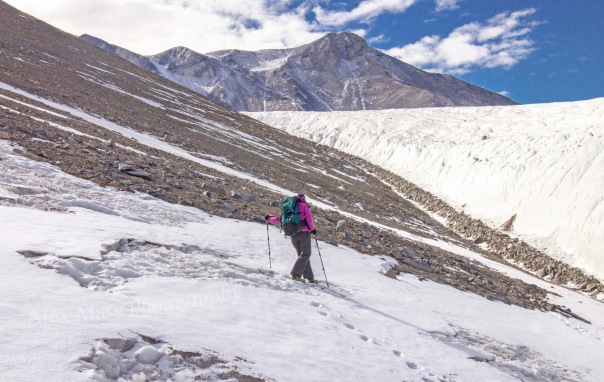
Renee offered to join me on a hike up the mountainside towards the ridgeline of Canada Glacier to check on the status of the melt in early December
When I tell people I work in Antarctica studying the deposition of pollutants into glacial melt, some people ask why I have to stay here for the whole summer season– instead of waiting around for the melt season each year, why can’t I just carve a block of ice out of a glacier, melt it in a lab, and study it there? Why spend my time living in a tent, collecting water at different times during the summer? The answer is that glaciers aren’t made of ‘pure’ water and don’t melt evenly; different components within the ice will melt at different times and the composition of meltwater itself will change throughout the summer.
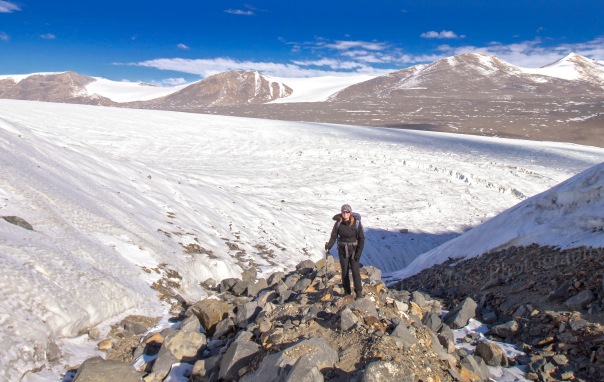
Higher up the mountainside with the tongue (bottom ‘fan’) of Canada Glacier in the background, on a ‘reconnaissance trip’ to check the status of the glacial surface melt.
Like most natural water around the world, glacial ice has additional compounds dissolved within it such as sodium, calcium, potassium, chloride, sulfate, and carbonate. These solutes decrease the freezing temperature of water so that if pure ice melts at 0C (32F), the impurities in glacial ice might instead melt at -2C (28F). (In other words, you need colder temperatures to freeze impure water, and those impurities will also melt out sooner than pure water.) So as temperatures warm up during the summer, if the average temperature in early December is -2C and the average temperature in early January is +1C, this means the impurities within the glacier will start to melt out earlier in December, leaving ‘purer’ ice behind to melt in January. This is called the ‘ionic pulse’; an initial burst of solutes and nutrients that preferentially melt out of a glacier at the beginning of the melt season before the temperatures are warm enough for the cleaner ice to start melting. In other areas of the world like the Colorado Rockies, the same type of ionic pulse releases nutrients from snowmelt during early spring and has significant impacts on plants and organisms that rely on those compounds for growth. Each spring you can see a spike in the nutrient load (concentration of solutes in the water) in rivers and streams that are fed by glaciers or snowmelt. So for my research, I can’t just carve out a bit of ice and take it back to a lab to study it because the environmental conditions of Antarctica itself will affect which parts of the ice melt at different times, which in turn affects the chemistry and composition of the meltwater that I study.
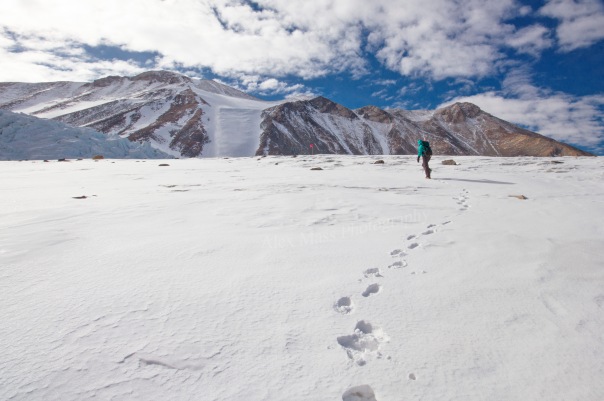
There is still a lot of snow that hasn’t yet ablated from the surface of the glacier. Snow has a very high albedo (reflectivity to light) that prevents sunlight from penetrating down to the ice level beneath it, delaying the beginning of the melt season.
So even though I study glacial melt, I need to be here in the mountains BEFORE the initial ionic pulse of melting starts, in order to make sure I’m here when it happens and I don’t miss it. Then I’ll continue to take different samples during the whole season as the composition of the meltwater changes, to keep examining how atmospheric pollution reacts with and deposits into the different stages of melt. This year, though, the pulse hasn’t happened yet– we need to have a few nice, warmer days all in a row to get the process going. It’s like pushing a boulder down a hill- a few consistent shoves in the right direction will get the ball rolling and once that happens it will gain enough momentum that it can’t be stopped, and likewise a few warm days are enough to initiate glacial melt strong enough that the occasional colder day won’t stop it (until the end of the summer season when it is always below freezing again). Last year, we had a few warm days in a row that initiated that downhill ‘push’. This year, the cycle of ‘cold! warm! cold! warm!’ days hasn’t offered a long enough temperature consistency to start the process yet. And so I wait…
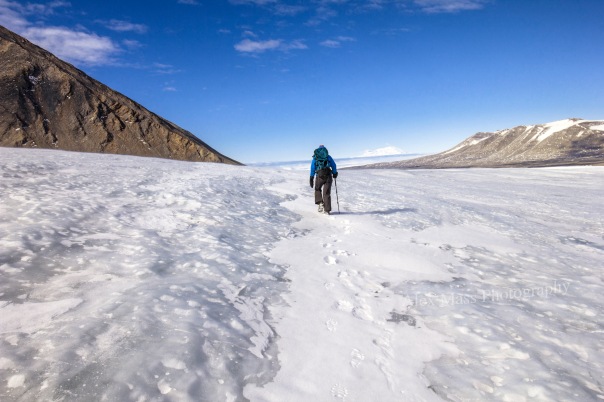
Trekking across a glacial surface of dense ice. When we finally do have a few consecutive days of warm weather, (hopefully soon!) the ionic pulse is going to surge quickly and start to melt out of the glacier like a sponge.
Posted on 2014, in (Current) Season 4: Life on Transantarctic Mountain Glaciers, 2014 (12/21) Reconnaissance for the Ionic Pulse. Bookmark the permalink. 2 Comments.
Wow! Great pics and write-up! We’re very much in awe of what you’re doing, Alex!
How interesting! I have a first grade class and would love to Skype with you about living in Antarctica. Would you be interested?